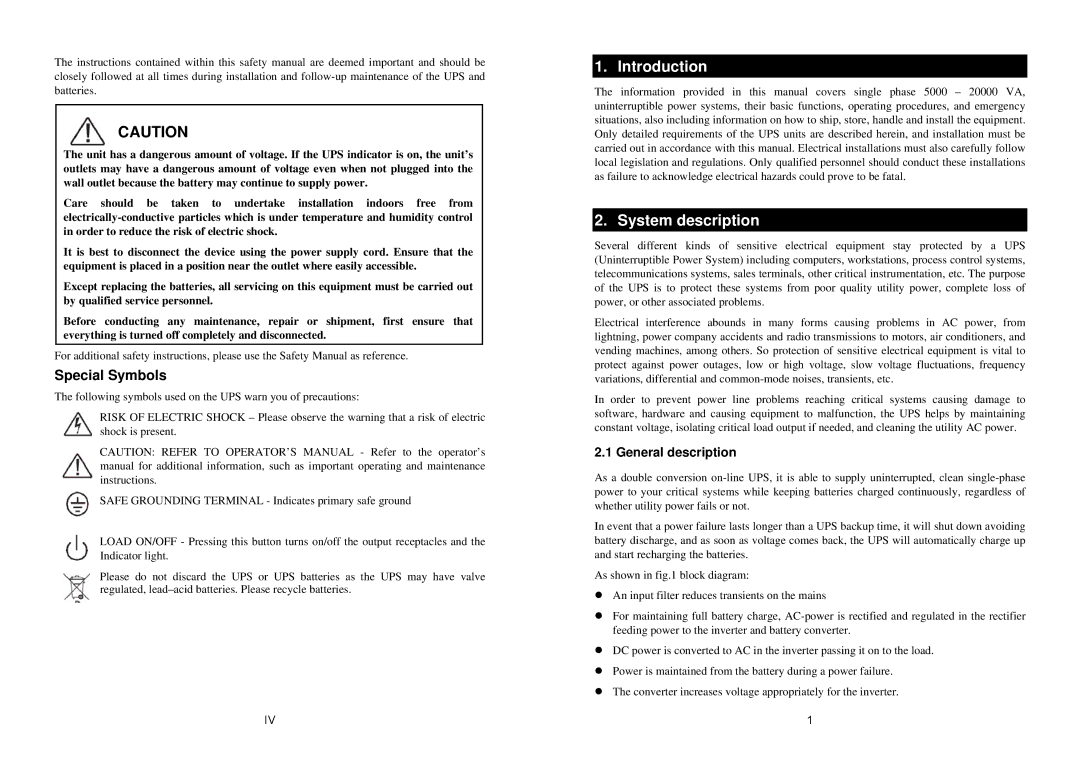
The instructions contained within this safety manual are deemed important and should be closely followed at all times during installation and
CAUTION
The unit has a dangerous amount of voltage. If the UPS indicator is on, the unit’s outlets may have a dangerous amount of voltage even when not plugged into the wall outlet because the battery may continue to supply power.
Care should be taken to undertake installation indoors free from
It is best to disconnect the device using the power supply cord. Ensure that the equipment is placed in a position near the outlet where easily accessible.
Except replacing the batteries, all servicing on this equipment must be carried out by qualified service personnel.
Before conducting any maintenance, repair or shipment, first ensure that everything is turned off completely and disconnected.
For additional safety instructions, please use the Safety Manual as reference.
Special Symbols
The following symbols used on the UPS warn you of precautions:
RISK OF ELECTRIC SHOCK – Please observe the warning that a risk of electric shock is present.
CAUTION: REFER TO OPERATOR’S MANUAL - Refer to the operator’s manual for additional information, such as important operating and maintenance instructions.
SAFE GROUNDING TERMINAL - Indicates primary safe ground
LOAD ON/OFF - Pressing this button turns on/off the output receptacles and the Indicator light.
Please do not discard the UPS or UPS batteries as the UPS may have valve regulated,
IV
1. Introduction
The information provided in this manual covers single phase 5000 – 20000 VA, uninterruptible power systems, their basic functions, operating procedures, and emergency situations, also including information on how to ship, store, handle and install the equipment. Only detailed requirements of the UPS units are described herein, and installation must be carried out in accordance with this manual. Electrical installations must also carefully follow local legislation and regulations. Only qualified personnel should conduct these installations as failure to acknowledge electrical hazards could prove to be fatal.
2. System description
Several different kinds of sensitive electrical equipment stay protected by a UPS (Uninterruptible Power System) including computers, workstations, process control systems, telecommunications systems, sales terminals, other critical instrumentation, etc. The purpose of the UPS is to protect these systems from poor quality utility power, complete loss of power, or other associated problems.
Electrical interference abounds in many forms causing problems in AC power, from lightning, power company accidents and radio transmissions to motors, air conditioners, and vending machines, among others. So protection of sensitive electrical equipment is vital to protect against power outages, low or high voltage, slow voltage fluctuations, frequency variations, differential and
In order to prevent power line problems reaching critical systems causing damage to software, hardware and causing equipment to malfunction, the UPS helps by maintaining constant voltage, isolating critical load output if needed, and cleaning the utility AC power.
2.1 General description
As a double conversion
In event that a power failure lasts longer than a UPS backup time, it will shut down avoiding battery discharge, and as soon as voltage comes back, the UPS will automatically charge up and start recharging the batteries.
As shown in fig.1 block diagram:
zAn input filter reduces transients on the mains
zFor maintaining full battery charge,
zDC power is converted to AC in the inverter passing it on to the load.
zPower is maintained from the battery during a power failure.
zThe converter increases voltage appropriately for the inverter.
1
